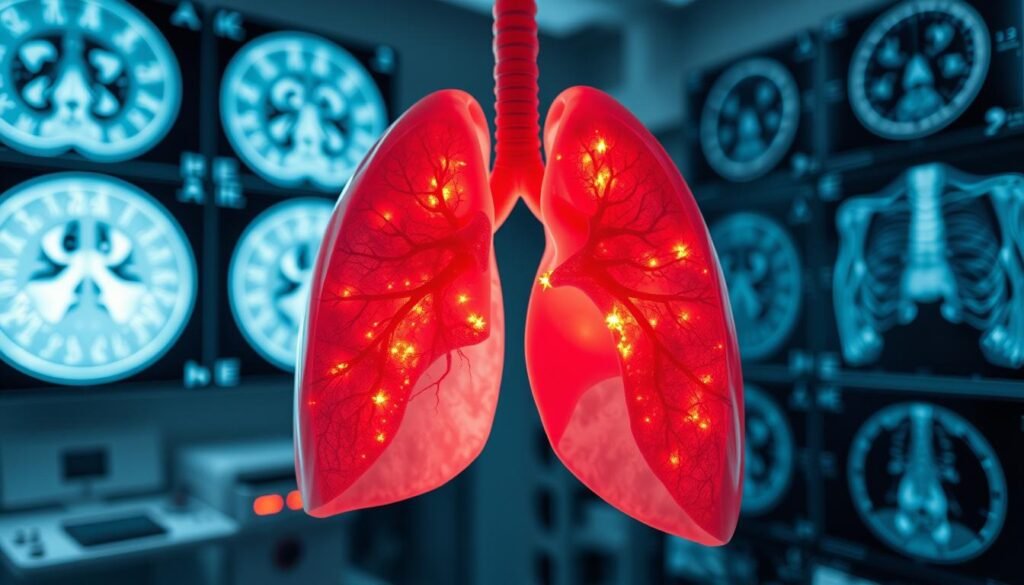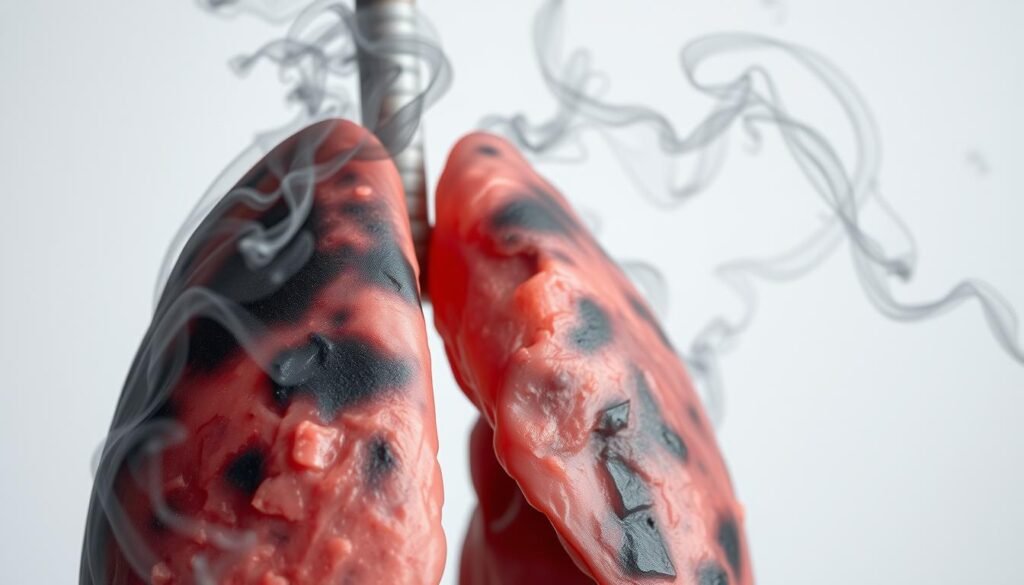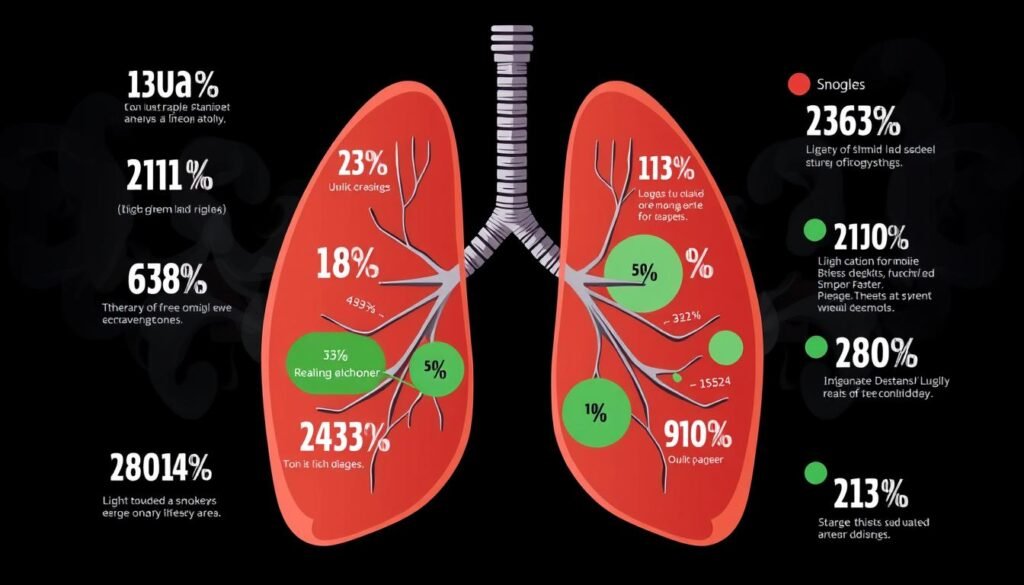Lung cancer takes more lives worldwide than the other top three cancers combined. This fact stresses the need to understand lung lining cancer better. It starts in the cells lining the lungs. What makes this scary is many don’t know the symptoms of lung cancer until it’s quite advanced. Knowing about these signs early on could help save many lives.
This guide will give you detailed information on lung lining cancer. You’ll learn about its symptoms, treatments, and why quick action is critical. By keeping an eye on the symptoms of lung cancer, we can catch it early. This can lead to better management and healthier lives.
It’s crucial to know the risk factors and the latest in medical technology and treatments for lung cancer. This knowledge benefits anyone worried about their lung health.
Key Takeaways
- Lung cancer is the top reason for cancer-related deaths among men and women.
- Smoking leads to most lung cancer cases, affecting 90% of men and 80% of women.
- Knowing the symptoms of lung cancer aids in early detection.
- There are treatments for lung cancer, but not all can cure it.
- Leading a healthy life and avoiding risks can lower lung cancer chances.
- Quick diagnosis can improve management and outcomes significantly.
- High air pollution areas can up your risk of lung cancer.
Understanding Lung Cancer
Lung cancer is a major health issue because it’s widespread and has serious effects. We need more awareness and knowledge about it. This section covers what lung cancer is and the different types that exist. It gives readers a full understanding.
What is Lung Cancer?
Lung cancer begins with abnormal cell growth in the lungs. It’s a top cause of cancer deaths worldwide. It harms the respiratory system, leading to various health issues. Smoking is a key factor, causing about 90% of lung cancer cases.
Each year, about 235,000 new cases are diagnosed in the U.S. This shows a big public health problem. Interestingly, nearly 60% of cases occur in people who have stopped smoking. This highlights the long-term effects of smoking.
Types of Lung Cancer
Knowing the types of lung cancer is key for correct diagnosis and treatment. There are two main kinds: small cell lung cancer and non-small cell lung cancer. Non-small cell lung cancer makes up 85% to 90% of cases. It includes subtypes like adenocarcinoma, squamous cell carcinoma, and large cell carcinoma.
Small cell lung cancer is about 10% to 15% of cases and is mainly seen in heavy smokers. Identifying the type of lung cancer is vital. It helps create a treatment plan that targets the cancer’s specific traits.
What is Lung Lining Cancer?
Lung lining cancer, or pleural cancer, starts in the pleural lining around the lungs. It mainly includes diseases like mesothelioma, linked to asbestos exposure. Knowing what lung lining cancer means is key for good assessment and treatment.
Definition and Characteristics
Lung lining cancer characteristics show it progresses slowly. This makes it hard to detect early. Many people learn they have it when it’s advanced. This impacts their treatment choices and survival chances greatly. For example, around 2,700 people in the UK find out they have mesothelioma each year. Most of them are over 75.
Most mesothelioma cases, about 95%, occur in the chest area, not the abdomen. This shows how common this type of lung lining cancer is. While usually linked to asbestos, sometimes a non-cancerous version develops in the lung lining.
For more on lung cancer types, including pleural cancer, check this resource. Knowing about lung lining cancer helps with accurate diagnosis. This means patients can get the treatment they need faster.
Symptoms of Lung Lining Cancer
Finding lung lining cancer early can be hard. The early signs are often not obvious. Knowing both common and advanced symptoms is key for early treatment.
Common Symptoms to Watch For
There are several main symptoms of lung cancer to look out for. People need to pay attention to:
- Persistent cough that does not improve over time
- Chest pain that may worsen with deep breaths
- Wheezing or recurring respiratory issues
- Shortness of breath, potentially due to airway obstruction
Spotting these early can lead to better chances of treatment. If you have these symptoms, see a doctor quickly.
Advanced Symptoms of Lung Cancer
As it gets worse, lung cancer can cause more severe symptoms. These include:
- Coughing up blood
- Significant weight loss without trying
- Loss of appetite
- Intense fatigue
It’s important to know these advanced symptoms. They can mean the cancer is progressing and needs urgent care.
| Symptom | Type |
|---|---|
| Persistent cough | Common |
| Chest pain | Common |
| Wheezing | Common |
| Shortness of breath | Common |
| Coughing up blood | Advanced |
| Weight loss | Advanced |
| Loss of appetite | Advanced |
| Fatigue | Advanced |
Knowing these symptoms helps you act fast. It’s important to talk to doctors for checks and treatment plans.
Diagnosis of Lung Lining Cancer
Doctors check for lung lining cancer using a step-by-step method. They go over medical history and do a physical check-up. They also use imaging tests to spot anything unusual in the lungs.
Diagnostic Tests Explained
The process begins with looking at symptoms and risk factors. Doctors often start with a chest X-ray to get a look at the lungs. This can show signs of cancer or other lung problems. They might also test mucus coughed up to find abnormal cells.
For people over 50 at high risk, getting checked annually with low-dose CT scans is recommended. This catches early signs. Confirming cancer involves biopsies, where samples are taken to look for cancer cells. Tools like bronchoscopy, needle biopsy, and mediastinoscopy are used.
Imaging Techniques Used
Several imaging techniques are important for checking lung cancer. Besides the basic chest X-ray, CT scans, MRIs, and PET scans give detailed images. CT scans, especially, are better than X-rays at finding lung tumors.
These imaging tests show how much cancer there is and help with treatment plans. MRI scans are good for checking if the cancer has spread to the brain or liver. PET scans show how advanced the cancer is. Sometimes, bone scans are done to see if cancer reached the bones.

Treatment Options for Lung Lining Cancer
Treating lung lining cancer involves different methods based on what the patient needs. There are several treatments like surgery, chemotherapy, radiation therapy, and care for symptom relief. The treatment chosen depends on the cancer’s type and stage, and the patient’s health.
Overview of Treatment Modalities
People with lung lining cancer often use many treatments to handle symptoms and stop the disease from getting worse. These treatments include:
- Surgery for lung cancer: This can mean removing part or all of the affected lung to help the patient live longer.
- Chemotherapy for lung cancer: A treatment that fights cancer cells all over the body.
- Radiation therapy in lung cancer: This targets tumors directly, can ease symptoms, and helps patients feel better.
- Palliative care: Aims to ease symptoms and stress, no matter the disease’s stage.
Surgery and Its Importance
Surgery is crucial for treating lung lining cancer that hasn’t spread. A lobectomy, or removing a lung lobe, can greatly increase survival. If done early and appropriately, surgery can lead to good outcomes.
Role of Chemotherapy and Radiation Therapy
Chemotherapy attacks fast-growing cells and is given through the veins. It is often used alongside other treatments, especially when cancer has spread. Radiation therapy helps by shrinking tumors and easing pain. This improves the patient’s life quality. These treatments are vital for managing lung lining cancer effectively.
For more information about the stages and treatments, visit treatment options for non-small cell lung cancer.
Risk Factors for Lung Lining Cancer
It’s important to know what increases the risk of lung lining cancer. Smoking is the biggest risk, linked to 85% of cases. It shows how smoking greatly raises the chance of getting this disease.
Impact of Smoking on Lung Cancer Risk
Smoking badly affects lung health. Smokers may be 15 to 30 times more likely to get lung cancer than non-smokers. The more you smoke, the higher the risk. Besides smoking, our lifestyle and surroundings also play a role. If you’ve smoked before, your risk is higher. That’s why stopping smoking is key to lower your risk.
Lung cancer risk factorsaren’t just about tobacco.
Secondhand Smoke and Other Exposures
Breathing in secondhand smoke is also dangerous, causing about 3,000 deaths from lung cancer each year. Things in our environment like radon and asbestos add to the problem. They make it more likely for even non-smokers to get lung cancer. Work hazards like arsenic and cadmium increase the risk too. Knowing these risks can help us avoid them and protect against lung cancer.

Prevention Strategies for Lung Lining Cancer
Taking steps to prevent lung cancer is key. By quitting smoking and avoiding carcinogens, you can stay healthier. Knowing how to avoid these risks is beneficial for everyone.
Quitting Smoking and Its Benefits
Quitting smoking is a top way to prevent lung cancer. Most lung cancers are caused by smoking. If you stop smoking, your lung cancer risk can drop by 30% to 60% in ten years.
There are many resources to help people quit. Nicotine replacement, counseling, and support groups are some examples.
Minimizing Exposure to Carcinogens
Avoiding carcinogens is also important for lung health. This means staying away from harmful substances like asbestos and radon. It’s good to be in smoke-free places and check your home for radon to prevent lung cancer.
Choosing a lifestyle that limits carcinogen exposure is crucial. It greatly helps your lungs stay healthy.
| Prevention Strategy | Description | Impact on Risk |
|---|---|---|
| Quitting Smoking | Stopping tobacco use and seeking cessation support | Reduces risk by 30% to 60% after 10 years |
| Minimize Carcinogen Exposure | Avoid known carcinogens like asbestos and radon | Lowers risk of developing lung cancer |
| Regular Health Checkups | Routine screenings for early detection | Facilitates early intervention and treatment |
| Healthy Diet | Increased intake of fruits and vegetables | May lower risk when confounding factors are considered |
Lung Cancer Statistics and Trends
Lung cancer is a major health problem worldwide. Lung cancer incidence rates show big differences around the world. Because of this, we need to focus on raising awareness and preventing this disease. Knowing more about these trends helps us understand how widespread lung cancer is.
Current Statistics on Lung Cancer Incidence
Lung cancer is the most common cancer and the leading cause of cancer deaths. It causes about 25% of cancer deaths. High rates are found in North America, East Asia, and Europe. While men’s rates have dropped over 40 years, women’s rates in some areas are going up. In fact, 18% of all cancer deaths globally are due to lung cancer.
| Region | Incidence Rate (per 100,000) | Trends |
|---|---|---|
| North America | 76 (2005), 59 (2014) | Declining in males |
| East Asia | High | Consistent increase in females |
| Central/Eastern Europe | High | Unchanged or increasing |
Smoking and Lung Cancer Statistics
Smoking hugely increases the risk of lung cancer. Smokers are 15 to 30 times more likely to get the disease than non-smokers. Around 80–85% of lung cancer cases come from smoking. Among veterans, half used to smoke and 40% still did when they found out they had lung cancer. This shows that smoking is a key risk factor for lung cancer. Studies highlight the importance of stopping smoking to lower death rates from this cancer.

Lung Lining Cancer: Living with and Beyond
Lung lining cancer brings many challenges for patients and their families. It’s key to manage symptoms and focus on comfort and well-being. Using medical treatments and lifestyle changes helps patients cope better.
Managing Symptoms and Side Effects
Relieving symptoms is crucial for lung lining cancer patients. Key points include pain and breathing management, nutrition, and emotional support:
- Pain management: Medications help improve life quality.
- Breathing support: Oxygen therapy or exercises enhance lung function.
- Nutritional support: A balanced diet boosts strength and energy.
- Emotional well-being: Therapy helps deal with stress and anxiety.
These strategies promote a proactive approach to care, tailored to individual needs.
Support Systems and Resources
Robust support systems are key during the cancer journey. Lung cancer patients find support in different ways:
- Support groups: Offer comfort and shared experiences.
- Counseling services: Provide emotional support.
- Patient advocacy organizations: Offer resources and community support.
A strong network helps share struggles, making patients feel supported while fighting lung lining cancer.
Conclusion
Understanding lung lining cancer is very important. Knowing early symptoms like a constant cough and chest pain helps. This way, patients can get checked early.
It’s key to know how much smoking and the environment, like radon, lead to lung cancer. Stop smoking and stay away from harmful exposures to prevent it. By being aware, people can take better care of their health and seek the right screenings and treatment.
Taking a full approach to lung cancer is crucial. This means prevention, finding it early, and getting the right treatment. For more info on lung cancer symptoms and early signs, check out this useful guide. It helps in making informed choices.